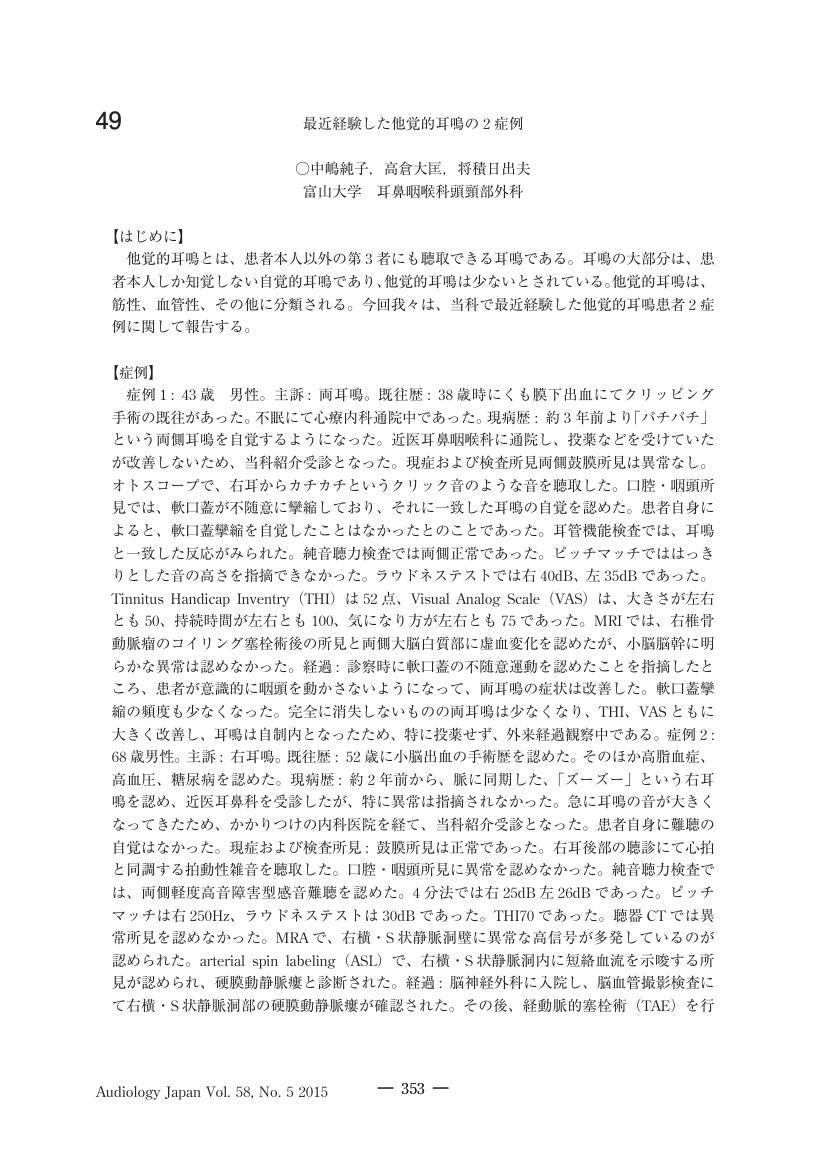2 0 0 0 OA COVID-19流行期がために診断に苦慮した中咽頭癌症例について
- 著者
- 中里 瑛 朝日 香織 将積 日出夫
- 出版者
- 富山大学医学会
- 雑誌
- Toyama Medical Journal (ISSN:21892466)
- 巻号頁・発行日
- vol.33, no.1, pp.51-55, 2023 (Released:2023-03-31)
- 参考文献数
- 12
COVID19流行期における咽頭疾患への対応は耳鼻咽喉科医として大変苦慮するところである。当科では咽頭内視鏡検査の際には,日本耳鼻咽喉科学会や英国耳鼻咽喉科学会が推奨する感染対策に従い,診察医はFull-PPE対応,患者はサージカルマスク着用しつつ鼻腔のみを出して経鼻からのチェックをおこなっていた。この方法は咽頭刺激による咳反射で発生するエアロゾルが飛散しにくく,鼻腔から上・中・下咽頭や喉頭を観察できる有用な方法である。しかし,この方法で施行した内視鏡検査や頸部針細胞診では悪性所見を発見できず,サージカルマスクを外して経口で施行した内視鏡検査や口蓋扁桃を触診することではじめて中咽頭癌の頸部リンパ節転移と診断することができた頸部のう胞性腫瘤の症例を経験した。この症例の診断には約3カ月を要してしまった。このことからCOVID19流行期においても状況に応じて経口からの内視鏡観察をおこなう必要性があることを反省の意味を込め報告する。
- 著者
- 渡辺 行雄 水越 鉄理 中川 肇 大井 秀哉 将積 日出夫 安村 佐都紀 中江 公裕 北原 正章 矢沢 代四郎 渡辺 勇
- 出版者
- Japan Society for Equilibrium Research
- 雑誌
- Equilibrium Research (ISSN:03855716)
- 巻号頁・発行日
- vol.50, no.7, pp.1-10, 1991
- 被引用文献数
- 9 2
During the past 14 years from 1975 to 1989, two-nation-wide surveys of Meniere's disease have been carried out by the Vestibular Disorders Research Comittee of Japan, supported by the Ministry of Health and Welfare of Japan. However, an epidemiological case-control-study including normal subjects has not yet been performed by this committee.<BR>In this third survey, therefore, 148 patients with definite Meniere's disease, 138 with non-Meniere vertigo, 113 with rhinolaryngological disorders, and 165 normal control subjects were collected by the 16 mem-bers of the Research Committee from June 1990 to November 1990. The controls were selected to match as closely as possible the sex, age and location of the Meniere's disease patients.<BR>The characteristic epidemiological features of Meniere's disease in Japan were :<BR>1) Sex-ratio : 63 males to 85 female.<BR>2) Age-distribution : Peak at 40-49 years for males and 30-39 years for females.<BR>3) Season and Time of Onset : Often initial vertigo attacks occurred in the afternoon or in the morning.<BR>4) Occupational Distribution : There was a higher incidence of Meniere's disease among technicians or white-collar workers than among farmers, laborers engaged in blue-collar work, as in the 1st and 2nd surveys. However, the number of house-wives was lower in this 3rd survey.<BR>5) Personal characteristics : In patients with Meniere's disease, precisionism and neurosis were more frequently observed than in non-Meniere's vertigo.<BR>6) Preceding Events : Mental and physical fatigue before vertigo attacks was frequent in Meniere's disease patients.<BR>These epidemiological features reconfirm that the occurrence of vertigo attacks in Meniere's disease is influenced much more by individual factors than by environmental factors, as was found in the 1st and 2nd Nation-wide surveys. However, a marked difference in sex ratio with female preponderance was found in the 3rd survey.<BR>The incidence of bilateral Meniere's disease was 16.2% (24/148), higher than in the 1st and 2nd surveys.
1 0 0 0 OA 最近経験した他覚的耳鳴の2症例
- 著者
- 中嶋 純子 高倉 大匡 将積 日出夫
- 出版者
- 一般社団法人 日本聴覚医学会
- 雑誌
- AUDIOLOGY JAPAN (ISSN:03038106)
- 巻号頁・発行日
- vol.58, no.5, pp.353-354, 2015-09-30 (Released:2016-02-04)
1 0 0 0 気象とメニエール病発作との関連性について(第2報)
- 著者
- 伊東 宗治 渡辺 行雄 将積 日出夫 麻生 伸 浅井 正嗣 本島 ひとみ 水越 鉄理
- 出版者
- 一般社団法人 日本めまい平衡医学会
- 雑誌
- Equilibrium Research (ISSN:03855716)
- 巻号頁・発行日
- vol.53, no.10, pp.6-10, 1994
We investigated the influence of a cold front (CF) on the onset of Meniere's disease (MD) and concluded that the onset of MD was influenced by the passing of a CF. But it was not clear whether patients with MD were stressed by the passing of a CF or the passing of a CF directly influenced the inner ears. Among the patients with MD who visited the Neuro-Otological clinic of the Toyama Medical and Pharmaceutical University Hospital from 1987 to 1992, 67 were sure of the date of the first attack and were chosen for the study. In 36 the first attack was on a day when a CF was passing or on the next day, so they were studied epidemiologically.<BR>1) Age: more of these 36 patients were over 40 years of age than in the group of 31 patients with no definite relationship between CF and MD.<BR>2) Hearing: in the 36 patients hearing was poorer than in the others.
